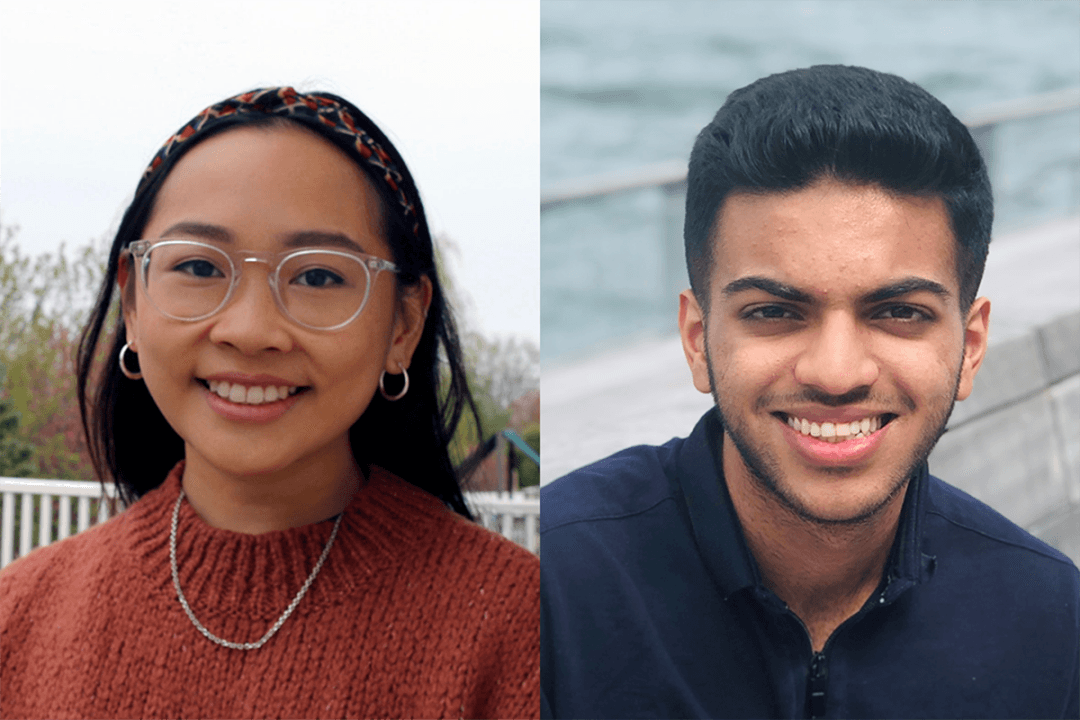When the COVID pandemic emerged last spring, physics major Ujwal Kumar was one of the thousands of GW students—and millions like him around the world—whose lives were turned upside down by anxiety about the future. He worried about his parents in India, his sister in New York City and his research with Assistant Professor of Physics Alexander van der Horst.
As the university transitioned to remote learning, Kumar, a rising senior in the Columbian College of Arts and Sciences, was in the midst of an astrophysics project with van der Horst. They were identifying the light of extreme objects across the universe like gamma ray bursts. “When the coronavirus first hit. I was definitely concerned about how we were going to keep doing this,” said Kumar, who initially left campus in the spring to stay with his sister in Manhattan. “There was a lot of confusion about how remote research actually works.”
But even as they worked from remote locations, Kumar and other student researchers were able to study scientific phenomena that ranged from the farthest reaches of the universe to the depths of Hawaiian volcanos. They were part of Columbian College’s new STEM Summer Research Program, which was launched to encourage undergraduate students majoring in biology, chemistry, neuroscience, physics and psychology to work with faculty mentors on individual research projects over the summer months. While the cohort was smaller than anticipated due to the pandemic, two students—Kumar and rising senior biology major Alison Pagalilauan—were able to work remotely on compelling research projects. A third student, rising senior neuroscience major Kirsten Carmody, received the Robert Vincent Fellowship to continue working with Assistant Professor of Cognitive Neuroscience Gabriela Rosenblau on characterizing preferences of adolescents with autism and their role in social learning.
“We are proud of these students for persevering on their projects despite the challenges they faced with the pandemic,” said Associate Dean of Undergraduate Studies Rachel Riedner. “With limited access to our labs, they managed to get creative with online resource tools to assist their research.”
Kumar’s astrophysics research involves examining celestial sources with computer codes. From his laptop, Kumar generated machine learning codes that could recognize and identify light sources across the universe. “Arguably, virtual research has raised my productivity and allowed me to venture into different intricacies of astrophysics,” he said. The greatest challenge, he said, has been trying to collaborate with fellow student researchers in physics and computer science. “On the one hand, I’ve had to learn a lot of coding on my own,” he said. “But I really miss the team work. Having a network around of friends and colleague who I can consult with is something I probably took for granted.”
Like Kumar, Pagalilauan was engrossed in research when the pandemic first struck. She has been working with Assistant Professor of Biology Jimmy Saw on analyzing meta-genomic data from steam vent samples collected in Hawaii’s Kilauea East Rift Zone. Luckily, many of the samples had already been sequenced for their genomes. Working remotely from her New Jersey home, Pagalilauan has used an online interface called KBase to analyze the biogenetic information and determine if the samples are novel species that should be further sequenced. Saw, who collected the samples while he was in Hawaii in 2019, is pleased with the results thus far. “We are progressing well even without having access to my wet lab,” he said.
Pagalilauan has continued to consult remotely with her team, which includes two other undergraduate students. “Our lab is meeting virtually on a regular basis to discuss project details. It has required a lot of flexibility, but we actually meet more than we did in-person.” In fact, she believes that she has had more contact with her faculty mentor than she did before the pandemic. The team has structured lectures, discussion sessions and even virtual office hours. “It almost feels like we're taking a class together,” Pagalilauan said.
Likewise, Carmody, who has been a researcher in Rosenblau’s lab for two years, says the latest challenges are not stopping her from pursuing her passion.
“I have learned that I am passionate about clinical research and conducting an independent research study is something that excites me,” Carmody explained. “I am eager to connect my research knowledge with my clinical experiences. This opportunity will help me enhance my understanding about a community that is not well understood.”
As the fall semester approaches, Riedner said the college will continue to help students find opportunities to stretch their research from the lab to the virtual environment.
“The pandemic illustrates how research truly is the engine of discovery, and that our well-being depends on continuous innovation,” she said. “We are committed to developing and cultivating a strong research infrastructure that includes the participation of our undergraduate students. Their work is more important now than ever.”


